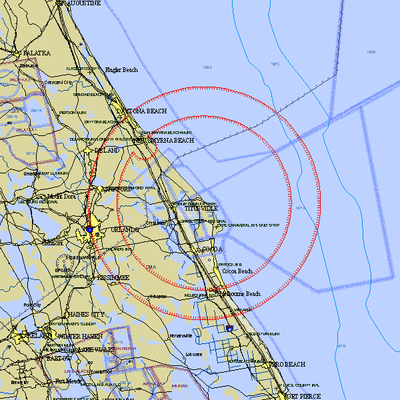 NOTAM Number: FDC 6/7945
NOTAM Number: FDC 6/7945
Issue Date: December 08, 2006 at 1504 UTC
Location: Cape Canaveral, Florida
Beginning Date and Time: December 09, 2006 at 1846 UTC
Ending Date and Time: December 10, 2006 at 0226 UTC
Reason for NOTAM: Temporary flight restrictions for Special
Security Reasons
Type: Security
Replaced NOTAM(s): N/A
Pilots May Contact: Miami Center (ZMA) Center, 305-716-1588
Affected Area(s)
Area A
Airspace Definition:
TFR Center: 30.6 nautical miles from MELBOURNE VOR/DME(MLB)
on the 004 radial (Latitude: 28º37'00"N, Longitude:
80º37'00"W)
Radius: 40 nautical miles
Altitude: From the surface up to but not including 18000 feet
MSL
Effective Date(s):
December 09, 2006 at 1846 UTC (December 09, 2006 at 1346 EST)
- December 10, 2006 at 0226 UTC (December 09, 2006 at 2126 EST)
Area B
Airspace Definition:
TFR Center: 30.6 nautical miles from MELBOURNE VOR/DME(MLB)
on the 004 radial (Latitude: 28º37'00"N, Longitude:
80º37'00"W)
Radius: 30 nautical miles
Altitude: From the surface up to but not including 18000 feet
MSL
Excluding
TFR Center: 20.8 nautical miles from ORMOND BEACH VORTAC(OMN) on
the 154 radial (Latitude: 28º59'31"N, Longitude:
80º56'11"W)
Radius: 4 nautical miles
Altitude: From the surface up to but not including 18000 feet
MSL
Effective Date(s):
December 09, 2006 at 1846 UTC (December 09, 2006 at 1346 EST)
- December 10, 2006 at 0226 UTC (December 09, 2006 at 2126 EST)
Operating Restrictions and Requirements
No pilots may operate an aircraft in the areas covered by this
NOTAM (except as described).
Except as specified below and/or unless authorized by
ATC:
A. All aircraft operations within a 30 NMR area listed
above are prohibited except for:
1. Military aircraft and aircraft associated with Cape
Canaveral operations, rescue/ recovery, medical/lifeguard,
emergency evacuation, law enforcement, department of state and fire
fighting operations which are permitted only with prior approval
from the appropriate ATC facility. Also, IFR regularly scheduled
commercial passenger and all-cargo carriers operating under one of
the following TSA-approved standard security programs/procedures:
aircraft operator standard security program (AOSSP), domestic
security integration program (DSIP), twelve five standard security
program (TFSSP) all cargo, or all-cargo international security
procedure (ACISP) and are arriving into and/or departing from 14
CFR part 139 airports are authorized transit with ATC approval.
2. VFR flight operations are prohibited except as provided
below.
3. IFR and VFR operations are authorized from the
following 3 airports, Arthur Dunn Air Park (X21), Merritt Island
(COI) and Space Coast Regional (TIX), as specified below: Effective
0612091846 UTC (1346 local 12/09/06) until 0612092246 UTC (1746
local 12/09/06).
A. Pre-take off requirements from X21 and COI:
1. Pilot must complete a vetting process conducted by NASA
law enforcement officers (LEO).
2. Upon completion of the vetting process, pilots must
call Orlando Approach Control, telephone 407-825-3398, and identify
themselves using the confidential pilot identification code
assigned to them.
3. Orlando Approach Control will assign a departure
control frequency, discrete transponder beacon code, and VFR
departure instructions or IFR clearance as appropriate, only after
verifying the confidential pilot identification code.
B. Pre-take off requirements from TIX:
1. Pilot must complete a vetting process conducted by NASA
LEO.
2. Upon completion of the vetting process, pilots must
contact TIX ground control. Include aircraft call sign and the
assigned confidential pilot identification code.
3. After verifying the confidential pilot identification
code, TIX ATCT will provide normal ATC services except all aircraft
must be assigned a discrete transponder code, and for those
aircraft departing the traffic pattern a departure control
frequency.
C. The pilot must maintain continuous radio communications
with ATC, squawking the assigned transponder code at all times, and
remain in radar contact while within the TFR airspace. Aircraft
operating under these procedures must fly the most expeditious
route practical and must not loiter within the 30 NMR TFR.
D. Flight operations must be at or below 4500 MSL while
within the 30 NM radius TFR.
E. Aircraft may depart X21/COI/TIX after vetting has
occurred and return to land at those airports. Each departure
requires additional vetting.
1. Fixed wing flight training, practice instrument
approaches, aerobatic flight, glider operations, parachute
operations, ultralight, hang gliding, balloon operations,
agriculture/crop dusting, animal population control flight
operations, and banner towing operations are not authorized.
B. Flight operations within the airspace between the 30
NMR and 40 NMR, (including 4.0 NM cut-out for X50, Massey Ranch
Airpark) listed above are permitted only in accordance with the
following procedures:
1. The pilot shall obtain a discrete transponder code and
clearance from the appropriate ATC facility prior to entering the
airspace.
2. The pilot shall maintain continuous radio
communications with ATC and display the assigned transponder code
at all times while within the TFR airspace.
3. Part 91 and VFR overflight traffic shall maintain an
indicated airspeed of 180 knots or less.
C. Information regarding the vetting process may be
obtained by calling 321-867-3441/6695 Monday through Friday between
1130 UTC (0630 local) until 2030 UTC (1530 local).
D. Pilots should check NOTAMs frequently for possible
changes to schedule and additional restrictions.
Unless otherwise authorized by ATC.

Other Information:
ARTCC: ZMA - Miami Center
Point of Contact: Miami Center
Telephone 305-716-1588
Authority: Title 14 CFR section 99.7
FMI: www.tfr.faa.gov,
Depicted TFR data may not be a complete listing. Pilots should not
use the information on this website for flight planning purposes.
For the latest information, call your local Flight Service Station
at 1-800-WX-BRIEF.
 Aero-News: Quote of the Day (05.20.25)
Aero-News: Quote of the Day (05.20.25) ANN's Daily Aero-Term (05.20.25): Handoff
ANN's Daily Aero-Term (05.20.25): Handoff ANN's Daily Aero-Linx (05.20.25)
ANN's Daily Aero-Linx (05.20.25) Airborne-NextGen 05.20.25: Drone Regs, Zero-Emission Cargo, Door-Dash Drone
Airborne-NextGen 05.20.25: Drone Regs, Zero-Emission Cargo, Door-Dash Drone Airborne 05.19.25: Kolb v Tornados, Philippine Mars, Blackhawk Antler Theft
Airborne 05.19.25: Kolb v Tornados, Philippine Mars, Blackhawk Antler Theft




